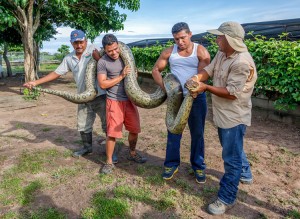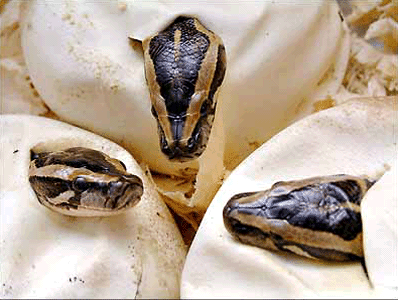Monster Monday: Anaconda
Monday, September 26th, 2016September 26, 2016
Large snakes have a well-established reputation as monsters in legend and folklore throughout the world. Monstrous snakes and serpents are common themes in the myths and iconography of many ancient cultures. Because snakes are sometimes poisonous and deadly, it is only natural that many people suffer from a general fear of snakes—so many, in fact, that the fear has a name: ophidiophobia. Small and slithery and creepy snakes can make people jump, but what about the monstrous anaconda, a snake so large it can swallow a small cow?

A giant anaconda is shown to a group of tourists in Los Llanos, Venezuela. Credit: © Vadim Petrakov, Shutterstock
Anaconda is the common name of a group of large snakes found in tropical South America. Anacondas (also called water boas) have greenish, yellowish, or brownish skin, often with many black rings or spots. The green anaconda (Eunectes murinas) may grow as long as 30 feet (9 meters) and weigh nearly 450 pounds (205 kilograms). Anacondas live near water, often swimming in rivers. Their main food is fish, but they also will eat birds, small mammals, and other reptiles. Anacondas kill by wrapping their coils tightly around prey and constricting (squeezing) it to keep it from breathing and to stop its heart.
Anacondas are top predators in their habitat, and they often prey on large animals, including capybaras, white-tailed deer, and even large caimans (reptiles closely related to the alligator). Anacondas are capable of eating such large prey because the skin and ligaments around their jaws easily stretch to fit around large objects. The two sides of an anaconda’s lower jaw are also joined by an elastic ligament, creating a mobile joint that allows the snake to move and stretch its jaws well beyond the size of its own head.
Large anacondas can be dangerous to people because of their size and strength. Fortunately, anacondas live in swampy habitats where people are unlikely to encounter them. Despite sensational stories that often circulate on the Internet, there are no known instances of anacondas eating people. In fact, there are only a couple of documented anaconda attacks on humans at all. Both were attacks on researchers trying to study the gigantic snakes. Fortunately, the scientists were rescued and the anaconda’s record remained clean. Like other snakes, anacondas defend themselves from enemies by retreating or, if cornered, by biting. Their bite is not poisonous, but their many teeth can inflict deep wounds.



